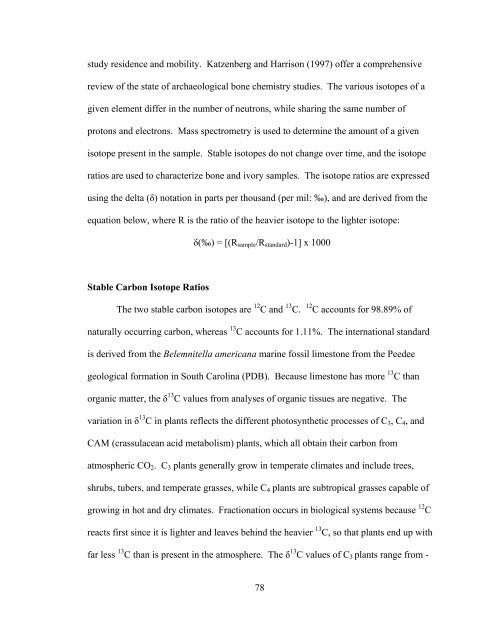Tracing the Source of the Elephant And Hippopotamus Ivory from ...
Tracing the Source of the Elephant And Hippopotamus Ivory from ...
Tracing the Source of the Elephant And Hippopotamus Ivory from ...
Create successful ePaper yourself
Turn your PDF publications into a flip-book with our unique Google optimized e-Paper software.
study residence and mobility. Katzenberg and Harrison (1997) <strong>of</strong>fer a comprehensive<br />
review <strong>of</strong> <strong>the</strong> state <strong>of</strong> archaeological bone chemistry studies. The various isotopes <strong>of</strong> a<br />
given element differ in <strong>the</strong> number <strong>of</strong> neutrons, while sharing <strong>the</strong> same number <strong>of</strong><br />
protons and electrons. Mass spectrometry is used to determine <strong>the</strong> amount <strong>of</strong> a given<br />
isotope present in <strong>the</strong> sample. Stable isotopes do not change over time, and <strong>the</strong> isotope<br />
ratios are used to characterize bone and ivory samples. The isotope ratios are expressed<br />
using <strong>the</strong> delta (δ) notation in parts per thousand (per mil: ‰), and are derived <strong>from</strong> <strong>the</strong><br />
equation below, where R is <strong>the</strong> ratio <strong>of</strong> <strong>the</strong> heavier isotope to <strong>the</strong> lighter isotope:<br />
Stable Carbon Isotope Ratios<br />
δ(‰) = [(Rsample/Rstandard)-1] x 1000<br />
The two stable carbon isotopes are 12 C and 13 C. 12 C accounts for 98.89% <strong>of</strong><br />
naturally occurring carbon, whereas 13 C accounts for 1.11%. The international standard<br />
is derived <strong>from</strong> <strong>the</strong> Belemnitella americana marine fossil limestone <strong>from</strong> <strong>the</strong> Peedee<br />
geological formation in South Carolina (PDB). Because limestone has more 13 C than<br />
organic matter, <strong>the</strong> δ 13 C values <strong>from</strong> analyses <strong>of</strong> organic tissues are negative. The<br />
variation in δ 13 C in plants reflects <strong>the</strong> different photosyn<strong>the</strong>tic processes <strong>of</strong> C3, C4, and<br />
CAM (crassulacean acid metabolism) plants, which all obtain <strong>the</strong>ir carbon <strong>from</strong><br />
atmospheric CO2. C3 plants generally grow in temperate climates and include trees,<br />
shrubs, tubers, and temperate grasses, while C4 plants are subtropical grasses capable <strong>of</strong><br />
growing in hot and dry climates. Fractionation occurs in biological systems because 12 C<br />
reacts first since it is lighter and leaves behind <strong>the</strong> heavier 13 C, so that plants end up with<br />
far less 13 C than is present in <strong>the</strong> atmosphere. The δ 13 C values <strong>of</strong> C3 plants range <strong>from</strong> -<br />
78

















